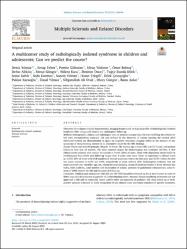A multicenter study of radiologically isolated syndrome in children and adolescents: Can we predict the course?

Göster/
Erişim
info:eu-repo/semantics/embargoedAccessTarih
2023Yazar
Yılmaz, DenizTeber, Serap
Gültutan, Pembe
Yıldırım, Miraç
Bektaş, Ömer
Alikılıç, Defne
Güngör, Mesut
Kara, Bülent
Öncel, İbrahim
Dilek, Tuğçe Damla
Saltık, Sema
Kanmaz, Seda
Yılmaz, Sanem
Tekgül, Hasan
Çavuşoğlu, Dilek
Karaoğlu, Pakize
Yılmaz, Ünsal
Orak, Sibğatullah Ali
Güngör, Olcay
Anlar, Banu
Üst veri
Tüm öğe kaydını gösterKünye
Yılmaz, D., Teber, S., Gültutan, P., Yıldırım, M., Bektaş, Ö., Alikılıç, D., ... & Anlar, B. (2023). A multicenter study of radiologically isolated syndrome in children and adolescents: Can we predict the course?. Multiple Sclerosis and Related Disorders, 79, 104948.Özet
Objectives: To evaluate clinical characteristics, imaging features and etiological profile of Radiologically Isolated Syndrome (RIS) along with clinical and radiological follow-up.
Methods: Demographic, clinical and radiological data of patients younger than 18 years fulfilling the criteria for RIS were retrospectively analyzed. RIS was defined by the detection of lesions meeting the revised 2010 McDonald Criteria for dissemination in space on magnetic resonance imaging (MRI) in the absence of any symptoms of demyelinating disease or an alternative cause for the MRI findings.
Results: There were total 69 patients (38 girls, 31 boys). The median age at index MRI was 15.7 years, and median follow-up time was 28 months. The most common reason for neuroimaging was headache (60.9%). A first clinical event occurred with median 11 months in 14/69 (20%) of cases. Those with oligoclonal bands (OCB) in cerebrospinal fluid (CSF) and follow-up longer than 3 years were more likely to experience a clinical event (p<0.05): 25% of those with OCB manifested clinical symptoms within the first year and 33.3% within the first two years compared to 6.3% and 9.4%, respectively in those without OCB. Radiological evolution was not associated with any variables: age, sex, reason for neuroimaging, serum 25-hydroxyvitamin D level, elevated IgG index, OCB positivity, total number and localization of lesions, presence of gadolinium enhancement, achievement of 2005 criteria for DIS and duration of follow-up.
Conclusion: Children and adolescents with RIS and CSF OCB should be followed-up for at least 3 years in order to detect any clinical symptoms suggestive of a demyelinating event. Because disease-modifying treatments are not approved in RIS and no consensus report justifies their use especially in pediatric RIS, close follow-up of OCB-positive patients is needed for early recognition of any clinical event and timely initiation of specific treatment.















